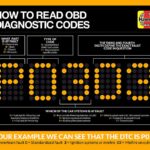Item 98614, often associated with OBD2 scanners, helps retrieve diagnostic trouble codes (DTCs) like the enigmatic “$10”. This code isn’t a standard OBD2 code defined by the Society of Automotive Engineers (SAE). Instead, “$10” typically represents a specific module or control unit within a vehicle’s onboard diagnostic system. This article explores potential meanings of the “$10” code in the context of OBD2 diagnostics.
Decoding the “$10” OBD2 Code with Item 98614
When using an OBD2 scanner like item 98614, encountering the “$10” code can be confusing. It often indicates the specific module being queried by the scanner. In the provided data, “$10” appears consistently alongside various data points from different tests and sensors. This suggests that “$10” designates the targeted control module for these readings. For instance, “MOD : $10” preceding sensor data likely means the data originates from module “$10”.
Analyzing the accompanying information is crucial. “Control Module $10 SAE J1850 VPW Vehicle Info. Not Supported Or Sto-red No Data” indicates this particular module utilizes the SAE J1850 VPW communication protocol. Crucially, this module either doesn’t support storing vehicle information or no data is currently available. This lack of stored data extends to stored codes, pending codes, and freeze frame data.
The subsequent data presents results for various OBD2 tests (e.g., O2 sensor tests, On-Board Monitor tests). Each line item displays the Test ID, Module ID (“MOD : $10”), measured value (MEAS), maximum and minimum acceptable values (MAX, MIN), and status (STS – OK or Fail). Examining these values alongside known parameters for each specific test can provide valuable diagnostic information. For instance, failed tests (“STS: Fail”) for specific IDs, like ID 06, ID 50, and ID 30, pinpoint areas requiring further investigation.
Further Analysis of $10 OBD2 Code Data with Item 98614
The provided data reveals both passing and failing test results. While “STS : OK” suggests proper functioning, failed tests require attention. Comparing the measured values (MEAS) against the minimum and maximum acceptable ranges (MIN and MAX) is vital. Failing tests often indicate a malfunctioning component or system related to the specific test ID. Referencing a comprehensive OBD2 code guide, along with vehicle-specific repair manuals, is necessary to interpret the failed test IDs accurately.
For example, ID 06 pertains to the catalytic converter monitor bank 1, while ID 50 relates to the evaporative system leak detection monitor. A “Fail” status for these IDs suggests potential issues within these respective systems.
Conclusion: Leveraging Item 98614 for $10 Code Diagnostics
Understanding that “$10” likely represents a specific module is key to deciphering the provided OBD2 data. Analyzing the associated test results, particularly the failed tests, will guide further diagnosis. Using item 98614 in conjunction with detailed OBD2 code definitions and vehicle-specific repair information is crucial for pinpointing the root cause of any automotive issue related to module “$10”. Always consult reliable automotive resources for accurate interpretations and safe repair procedures.
